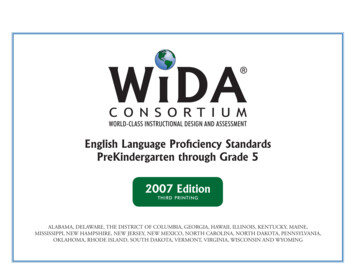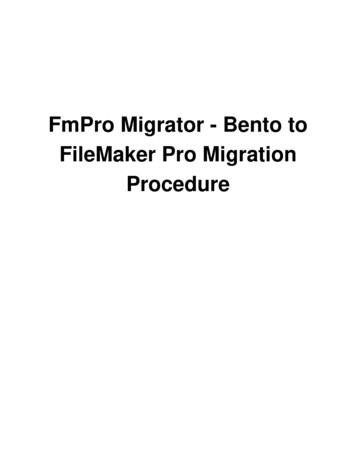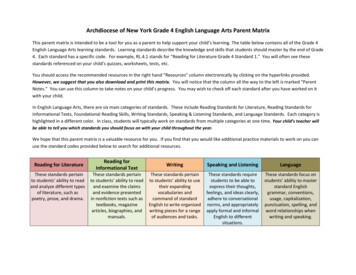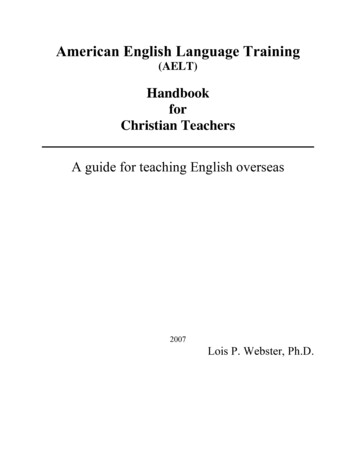
Transcription
WORLD-CLASS INSTRUCTIONAL DESIGN AND ASSESSMENTEnglish Language Proficiency StandardsPreKindergarten through Grade 52007 EditionTHIRD PRINTINGALABAMA, DELAWARE, THE DISTRICT OF COLUMBIA, GEORGIA, HAWAII, ILLINOIS, KENTUCKY, MAINE,MISSISSIPPI, NEW HAMPSHIRE, NEW JERSEY, NEW MEXICO, NORTH CAROLINA, NORTH DAKOTA, PENNSYLVANIA,OKLAHOMA, RHODE ISLAND, SOUTH DAKOTA, VERMONT, VIRGINIA, WISCONSIN AND WYOMING
Copyright NoticeThe WIDA English Language Proficiency Standards, 2007 Edition, PreKindergarten through Grade 12 (“WIDA ELP Standards”) are owned bythe Board of Regents of the University of Wisconsin System on behalf of the WIDA Consortium. The WIDA ELP Standards are protectedby United States copyright laws and may not be reproduced, modified, or distributed without the prior written permission of WCER andthe Board of Regents of the University of Wisconsin System. The WIDA ELP Standards are for your personal, noncommercial use only. Youmay not alter or remove any trademark, copyright or other notice from copies of this booklet.Fair use of the WIDA ELP Standards includes reproduction for the purpose of teaching (including multiple copies for lesson planning). Ifyou are not sure whether your use of this booklet and the WIDA ELP Standards falls within fair use or if you want permission to use thecopyrighted WIDA ELP Standards for purposes other than personal or fair use, please contact the WIDA Consortium intellectual propertymanager, Jim Lyne, at jwlyne@wisc.edu or (608) 265-2262. 2007 Board of Regents of the University of Wisconsin System, on behalf of the WIDA Consortium—www.wida.us.Second printing, 2008Third printing, 2009
About the WIDA English Language ProficiencyStandardsdevelopment. Overall, the standards center on the languageneeded and used by ELLs to succeed in school.WIDA’s English Language Proficiency Standards for EnglishLanguage Learners in Pre-Kindergarten through Grade 12:Frameworks for Formative and Summative Assessment andInstruction, 2007 edition, is a key component of the World-ClassInstructional Design and Assessment (WIDA) Consortium’sassessment system. WIDA’s vision of language proficiencyencompasses both social and academic contexts tied to schooling,particularly to standards, curriculum, and instruction. Bydeveloping these English language proficiency (ELP) standards,first published in 2004, the WIDA Consortium has respondedto this emergent vision to link language learning withacademic content. Furthermore, these ELP standards guide thedevelopment of test blueprints, task specifications, and ELPmeasures, primarily WIDA’s ACCESS for ELLs test.Each standard is organized by grade level cluster (PreK-K, grades1-2, grades 3-5, grades 6-8, and grades 9-12) and by languagedomain (listening, speaking, reading, and writing). Within eachgrade cluster and domain, there are five model performanceindicators (MPIs), one for each language proficiency level from 1,Entering, to 5, Bridging. All five MPIs focus on the same exampletopic from a content area reflected in the standard, forming a“strand” that illustrates the language development continuum.Each MPI contains three elements: a language function (e.g.,describe, justify), an example topic (e.g., weather, humanpopulations), and a form of support through level 4 (e.g., picturesor illustrations, working in small groups). The components ofthe ELP standards, from frameworks down to the elementsof an MPI, work together to form the standards document, acritical tool for educators of ELLs for curriculum development,instruction and assessment.Originally developed by consortium members with funding froma U.S. Department of Education Enhanced Assessment Grant,the standards are designed for the many audiences in the field ofeducation who are impacted by English language learners (ELLs).This second edition reflects an evolving understanding of theneeds of ELLs and their educators in the use of the ELP standardsas an instructional and assessment tool.Organization of the StandardsThere are five WIDA ELP Standards, which appear in twoframeworks: Summative (the outcomes of learning) andFormative (the processes of learning). The standards, identical forboth frameworks, reflect the social and academic dimensions ofacquiring a second language that are expected of ELLs in gradelevels PreK-12 attending schools in the United States. EachELP standard addresses a specific context for English languageThe WIDA English Language Proficiency Standards English Language Proficiency Standard 1: English language learnerscommunicate for Social and Instructional purposes within theschool setting. English Language Proficiency Standard 2: English language learnerscommunicate information, ideas, and concepts necessary foracademic success in the content area of Language Arts. English Language Proficiency Standard 3: English language learnerscommunicate information, ideas, and concepts necessary foracademic success in the content area of Mathematics. English Language Proficiency Standard 4: English language learnerscommunicate information, ideas, and concepts necessary foracademic success in the content area of Science. English Language Proficiency Standard 5: English language learnerscommunicate information, ideas, and concepts necessary foracademic success in the content area of Social Studies.Introductioni
IntroductionThe ELP standards are often abbreviated as Social andInstructional language, the language of Language Arts, thelanguage of Mathematics, the language of Science, and thelanguage of Social Studies.The Language Proficiency Levels and PerformanceDefinitionsThe five language proficiency levels outline the progression oflanguage development implied in the acquisition of English as anadditional language, from 1, Entering the process, to 6, Reachingthe attainment of English language proficiency. The languageproficiency levels delineate expected performance and describewhat ELLs can do within each domain of the standards. ThePerformance Definitions define the expectations of students ateach proficiency level. The definitions encompass three criteria:linguistic complexity—the amount and quality of speech orwriting for a given situation; vocabulary usage—the specificity ofwords or phrases for a given context; and language control—thecomprehensibility of the communication based on the amountand types of errors.The Performance Definitions (see page 3) are a key componentof the standards documents, and the use of the standardsand corresponding MPIs must be in conjunction with thePerformance Definitions. The MPIs, delineated by languageproficiency level, give expectations for what students shouldbe able to process and produce at a given proficiency level. ThePerformance Definitions describe how well the student can orshould be expected to do so. For example, the language function“describe” appears in MPIs at levels 1-4. What language doesa student at language proficiency level 2 need to produce inorder to “describe”? What can he or she reasonably be expectedto process to understand a description? How does this comparewith a student at language proficiency level 4? The languagefunction “describe” for a level 2 student may mean producingor comprehending phrases or short sentences using commonadjectives and modifiers, whereas a level 4 student may beexpected to process or use extended discourse incorporatingrelative clauses, similes or metaphors. This example illustrates howthe Performance Definitions are an essential companion to thestrands of MPIs.ii
Performance Definitions for the levels of English language proficiencyAt the given level of English language proficiency, English language learners will process, understand, produce, or use:6Reaching 5Bridging specialized or technical language reflective of the content area at grade levela variety of sentence lengths of varying linguistic complexity in extended oral or written discourse as required by the specifiedgrade leveloral or written communication in English comparable to proficient English peersthe technical language of the content areas;a variety of sentence lengths of varying linguistic complexity in extended oral or written discourse, including stories, essays,or reports;oral or written language approaching comparability to that of English proficient peers when presented with grade levelmaterial4Expanding specific and some technical language of the content areas;a variety of sentence lengths of varying linguistic complexity in oral discourse or multiple, related paragraphs;oral or written language with minimal phonological, syntactic, or semantic errors that do not impede the overall meaning ofthe communication when presented with oral or written connected discourse with occasional visual and graphic support3Developing general and some specific language of the content areas;expanded sentences in oral interaction or written paragraphs;oral or written language with phonological, syntactic, or semantic errors that may impede the communication but retainmuch of its meaning when presented with oral or written, narrative or expository descriptions with occasional visual andgraphic support2Beginning general language related to the content areas;phrases or short sentences;oral or written language with phonological, syntactic, or semantic errors that often impede the meaning of thecommunication when presented with one to multiple-step commands, directions, questions, or a series of statements withvisual and graphic support1Entering pictorial or graphic representation of the language of the content areas;words, phrases, or chunks of language when presented with one-step commands, directions,WH-questions, or statements with visual and graphic supportIntroductioniii
Example Topics and Genres: Content Related toWIDA’s English Language Proficiency StandardsThese examples, representative of state academic content standards, provide context for the English language development described in the strands of Model Performance Indicators.Standard 1:Social andInstructional languageExample Topics Classrooms Colors Feelings Games Hygiene & safety Music & movement Recreational objects &activities Routines School Self & family Social behavior Spatial relationsStandard 2:The language ofLanguage ArtsExample Genres & Topics Chants & songs Concepts about print Environmental print Fairy tales Forms of print Make-believe Nursery rhymes Picture books Rhyme Same & different Sounds & symbols(Phonemic awareness) Story elementsStandard 3:The language ofMathematicsExample Topics Attributes Equivalency Geometric shapes Measurement of time Non-standardmeasurement tools Number sense Numbers & operations Patterns Quantity Size Spatial relations Temperature WeightStandard 4:The language ofScienceExample Topics Air Animals Body parts Change in self &environment Colors Forces in nature Living & non-livingthings Night/Day Rocks Safety practices Scientific process Seasons Senses Water WeatherPreK - KStandard 5:The language ofSocial StudiesExample Topics Change from past topresent Classroom/School Clothing Community workers Families Food Friends Historical stories &legends Homes in a community/Habitats Location of objects &places Neighborhood Seasons Shelter Symbols & holidays Transportation1
PreK - K2ELP Standard 1: Social and Instructional Language, Formative FrameworkREADINGWRITINGLevel 1EnteringLevel 2BeginningLevel 3DevelopingLevel 4ExpandingLevel 5BridgingMusic &movementMimic musical beats ormovements modeledby teachers in a wholegroup (e.g., hop, hop,jump; one clap, twoclaps)Respond to chants basedon illustrations usinggestures, movement orinstruments modeledby teachers in a wholegroupRespond to songs basedon illustrations usinggestures, movement orinstruments modeledby teachers in a wholegroupInterpret songs, (e.g.,melodies from diversecultures) based onillustrations throughmovement or playingof instruments in smallgroups or whole classFollow lyrics of songsand respond accordinglyin small groups orwhole class (e.g., “Putyour right foot in ”)SpatialrelationsRepeat answers toquestions about positionor location of real-lifeobjects or persons (e.g.,“Where’s Maria? Here.”)Answer questionsor commands aboutposition or locationof real-life objects orpersons using relationalwords (e.g., “Where’sthe bunny? Over there.”)Relate position orlocation of real-lifeobjects or persons usingphrases (e.g., “under thetable,” “on the floor,”“in the corner”)Indicate contrastingor opposite positionor location of reallife objects or personsusing phrases or shortsentences (e.g., “Theball goes up. The ballcomes down.”)Describe position orlocation of real-lifeobjects or persons usingsentencesHygiene &safetyIdentify environmentalprint related to hygieneor safety aroundclassroom or school(e.g., washrooms, fireextinguisher) inL1 or L2Find real-life objectsor pictures related tohygiene or safety thatmatch environmentalprint around classroomor school (e.g., labels forsoap, sink) in L1 or L2Identify icons, symbolsand words related tohygiene or safety foundin environmental printor pictures aroundclassroom or school inL1 or L2Connect environmentalprint or pictures relatedto hygiene or safetyto teacher reading ofillustrated books inL1 or L2Share “oral reading” ofillustrated books relatedto hygiene or safety witha partnerGamesProduce drawings offamiliar games fromhome or school basedon class models usinglanguage experience inL1 or L2Describe familiargames from home orschool based on classmodels using languageexperience in L1 or L2Tell how to play familiargames from home orschool based on classmodels using languageexperience in L1 or L2Depict stories aboutfamiliar games fromhome or school withthe class using languageexperience in L1 or L2Create class books aboutgames from home orschool using languageexperience in L1 or L2Level 6- ReachingSPEAKINGLISTENINGExampleTopics
Level 2BeginningLevel 3DevelopingLevel 4ExpandingRecreationalobjects &activitiesIdentify recreationalobjects (e.g., balls,swings) from pictures(e.g., of school,playground or parkscenes) as directed orallyFollow one-step oraldirections from picturesof recreational objectsused in activities andoral statementsFollow two-step oraldirections pertainingto use of recreationalobjects in activitiesfrom pictures and oraldescriptions (e.g., “Pickup the ball. Then give itto a friend.”)Indicate use ofrecreational objects inactivities from picturesand complex oraldirections (e.g., “Showme how to pass the ballfrom person to person.”)Simulate playingactivities according topictures and sequentialoral descriptions (e.g.,“Make two rows.Choose a friend. Havethe friend go betweenthe rows.”)SocialbehaviorRepeat polite wordsor expressions whenmodeled (e.g., “Please”and “Thank you”) inshort dialoguesMake polite requestsfrom models or gestures(e.g., “Please sit down.”)Use polite language inconversations (e.g., roleplay, telephone talk)Give compliments,offer apologies orexpress gratitude withinconversationsAdapt polite languageto social situationsappropriate to audienceClassroomPair shapes of wordsrelated to illustratedclassroom objects withprint versionsMatch labeled picturesof familiar objects tothose in illustratedclassroom scenes (e.g.,“Here is a picture witha word inside. Find thesame word.”)Associate initial soundsor letters of illustratedclassroom objects withwords in printDistinguish letters,words and sentences inillustrated classroomscenesIdentify wordsor phrases withinillustrated classroomscenesRoutinesTrace, copy or depictdaily routines indrawingsReproduce initial lettersassociated with dailyroutines from labeleddrawings or illustratedmodelsLabel pictures of dailyroutines from illustratedmodels using wordswith invented spellingsDescribe daily routinesfrom illustrated modelsusing words and phraseswith invented spellingsCompose notes aboutdaily routines usingphrases or shortsentences with inventedspellingsWRITINGREADINGLevel 1EnteringLevel 5BridgingLevel 6- ReachingSPEAKINGLISTENINGExampleTopicsELP Standard 1: Social and Instructional Language, Summative FrameworkPreK - K3
PreK - K4ELP Standard 2: The Language of Language Arts, Formative FrameworkREADINGLevel 2BeginningLevel 3DevelopingLevel 4ExpandingLevel 5BridgingPoint to features of bigbooks in a large group(e.g., “cover,” “title,”“author,” “illustrator”)according to oralcommandsShow directionality ofprint in various sourcesin a large group (e.g.,left to right, beginning/ending of pages, top/bottom) according tooral commandsIdentify features oftext in context with apartner (e.g., spacesbetween words,sentences) according tooral directionsSort features of textwith a partner (e.g.,lower/upper case letters,periods/question marks)according to oraldirectionsMatch illustrations tooral reading of relatedsentences or shortstoriesNursery rhymesRepeat key words inrhymes from picturecues in a whole groupChant phrases or shortsentences in rhymesusing gestures frompicture cues in a wholegroupRehearse short rhymesusing gestures frompicture cues in whole orsmall groupsComplete short rhymesusing gestures frompicture cues in whole orsmall groupsRecite rhymes usinggestures from memoryin whole or smallgroupsSame &differentMatch pictures andicons with those that arethe same with a partnerSort pictures and iconsthat are the same ordifferent with a partnerClassify illustratedwords that are the sameor different with apartnerIdentify letters inillustrated words thatare the same or differentwith a partnerPoint out features ofwords that are the sameand different with apartner (e.g., capital v.lower case letters)Sounds &symbolsExperiment makingsymbols or letters frommodels using realia(e.g., in the sand, fromplay dough)Reproduce symbolsor letters from modelsusing realia (e.g., straws)Trace symbols or lettersassociated with picturesor realiaCopy symbols or lettersof beginning soundsfrom labeled pictures incontextProduce letters ofbeginning sounds frompictures in contextLevel 6- ReachingWRITINGLevel 1EnteringConcepts aboutprintSPEAKINGLISTENINGExampleTopics
ExampleTopicsLevel 2BeginningLevel 3DevelopingLevel 4ExpandingLevel 5BridgingIdentify pictures ofmake-believe animalsor persons as modeledorally (e.g., “Here isa make believe horse.Find another one.”)Match make-believepictures of animalsor persons to oralstatements (e.g., “Thismake-believe horse has ahorn. Find one withouta horn.”)Place pictures of makebelieve animals orpersons according tooral directions (e.g.,“First is the girl; she isthe princess. The princeis next to her.”)Arrange pictures ofmake-believe animalsor persons in logicalorder according to oraldirectionsOrganize pictures tocreate make-believestories (e.g., beginning,middle, end) accordingto descriptive oraldiscourseRhymeRepeat words or phrasesfrom rhymes supportedby illustrationsComplete phrases fromrhymes supported byillustrated modelsDescribe personsor events in rhymessupported byillustrationsDiscuss what happens(plot or events) inrhymes supported byillustrationsParaphrase rhymessupported byillustrationsForms of printDistinguish betweenillustrated examples ofprint and non-printMatch illustratedexamples of the sameform of print (e.g., twosigns, two magazines)Match functions ofdifferent forms ofprint with illustratedexamples (e.g., notes,lists, menus)Identify elements ofprint (e.g., letters,words, sentences)represented inillustrated formsFind elements of printin different forms(e.g., the same word indifferent fonts)EnvironmentalprintDraw or trace examplesof environmental print(e.g., from foods orclothes)Copy examples ofenvironmental printfrom labeled icons orobjectsProduce names ofobjects or iconsrepresented inenvironmental printusing invented spellings(e.g., sun)List examples ofenvironmental print inillustrated scenes usingicons, words or phraseswith invented spellingsUse examples ofenvironmental printin illustrated scenes toproduce phrases or shortsentences with eveLevel 6- ReachingWRITINGLevel 1EnteringELP Standard 2: The Language of Language Arts, Summative FrameworkPreK - K5
PreK - K6ELP Standard 3: The Language of Mathematics, Formative FrameworkLevel 2BeginningLevel 3DevelopingLevel 4ExpandingLevel 5BridgingAssociate size of reallife objects (e.g., “big,”“little”) with nonstandard measurementtools with a partner asmodeled orallySort real-life objectsby size (e.g., “short,”“long”) using nonstandard measurementtools with a partner asmodeled orallyDetermine size of reallife objects using nonstandard measurementtools (e.g., three handslong) with a partner asmodeled orallyEstimate size ofobjects from picturesusing non-standardmeasurement tools witha partner as directedorallyRank size of objectsdescribed accordingto non-standardmeasurement tools witha partner as directedorallyQuantityParticipate in andsupply quantity wordsin songs and chants in awhole group (e.g., “One,two, button my shoe.”)Complete phrasesin songs and chantsinvolving quantity in awhole group (e.g., “Onepotato, two potato,.”)Repeat verses and chantsinvolving quantity in awhole groupProvide sentencesor lines from songsand chants involvingquantity in a wholegroupInitiate and lead songsand chants involvingquantity in a wholegroupAttributesIdentify icons orpictures of real-lifeobjects with a singleattribute as modeled(e.g., “This is a toy. Findthe picture of a toy.”)Classify icons orpictures of real-lifeobjects with a singleattribute that belongand don’t belong to agroup as modeledIdentify icons orpictures of real-lifeobjects with twoattributes that belongto a group as modeled(e.g., “Find the big,yellow ones.”)Sort labeled iconsor pictures of reallife objects with twoattributes into groups asmodeledArrange labeled iconsor pictures of reallife objects with twoattributes by groupmembership as modeled(e.g., small animals withfour legs)EquivalencyDraw or trace matchedpairs of real-life objectsas modeled and directedorally (e.g., two hands,two feet)Connect 1:1 matchedsets of real-life objectsor pictures as modeledand directed orally (e.g.,three pencils with threepencils)Trace numerals thatcorrespond to matchedsets of real-life objectsor pictures as modeledand directed orallyMake or reproducenumerals up tonumber ten withvarious materials thatcorrespond to matchedsets of pictures fromword walls or wordbanks as modeledSupply numerals andnumber words thatcorrespond to matchedsets of pictures fromword walls or wordbanksREADINGLevel 6- ReachingWRITINGLevel NINGExampleTopics
ExampleTopicsLevel 3DevelopingLevel 4ExpandingLevel 5BridgingImitate pattern soundswith physical movementfrom modeling (e.g.,clap, snap, stomp)Select “What comesfirst, next or last?” inillustrated patternsaccording to oraldirectionsSort patterns from nonpatterns in picturesfrom oral directionsIdentify patterns frompictures (e.g., “girl, boy,girl, boy”) from oraldirectionsForm patterns frompictures (e.g., “the tallgirl, the short girl,the tall boy, the shortboy”) from detailed oraldirectionsSizeIndicate size of objectsin pictures (e.g., “small,”“big”) using gesturesand wordsSpecify size of objects inpictures (e.g., “a smallball,” “a big ball”)Compare the size oftwo objects in picturesusing phrases (e.g., “thesmaller ball”)Make statements aboutsize from pictures orillustrated scenes (e.g.,“This is the biggest.”)Make up relatedsentences or “stories”about differences insize using comparativelanguage fromillustrated scenesGeometricshapesMatch pictures ofreal-life objects (e.g.,books or windows) withfigures of geometricshapesClassify pictures of reallife objects according togeometric shapes (e.g.,circles or squares)Sort diagrams ofgeometric shapesaccording to their firstletter (e.g., “c” or “r”)Find pairs of matchingwords and diagrams ofgeometric shapesIdentify words forgeometric shapes fromlabeled diagramsTimeDraw, trace or copypictures from models toexpress times of dayDepict times of day(e.g., day or night)from illustrated scenesand models usingicons, letters or scribblewritingsExpress times of day(e.g., morning, noon ornight) from illustratedscenes and models usingwords with inventedspellingsComplete “story”starters related to timesof day from illustratedscenes and models usingwords or phrases withinvented spellingsProduce “stories” abouttimes of day relatedto events or actionsusing phrases or shortsentences with evel 2BeginningLevel 6- ReachingWRITINGLevel 1EnteringELP Standard 3: The Language of Mathematics, Summative FrameworkPreK - K7
PreK - K8ELP Standard 4: The Language of Science, Formative FrameworkLevel 2BeginningLevel 3DevelopingLevel 4ExpandingLevel 5BridgingIndicate change inself through gesturesor environment frompictures, according tooral commandsMatch pictures orphotographs ofoffspring with adultsfollowing oral models(e.g., from seeds toplants, from kittensto cats) as examples ofchangeIdentify stages ofdevelopment in picturesof self or organismsin the environmentfollowing oral models asexamples of changeSort illustratedactivities by stages ofdevelopment of selfor organisms in theenvironment followingoral models as examplesof changeSequence illustratedactivities that denotechange in self orenvironment (e.g.,life cycle of plants) asdirected orallySensesAssociate senses withphysical actions with apartner in L1 or L2Give examples of usesof senses with a partnerin L1 or L2 (e.g., “Isee ”)Describe everydayactivities that involvesenses with a partner inL1 or L2Explain why senses areuseful or important to apartner in L1 or L2Predict how senses areaffected by change (e.g.,injury, temperature)AnimalsMatch outlines ofanimals to pictures orobjects (e.g., fittingpuzzle pieces) with apartnerMatch pictures ofanimals with labels toanimal icons with apartnerSort pictures of animalswith labels by first letter(e.g., cat, cow) with apartnerFind animal wordsin picture books andclassrooms (e.g., onword walls, bulletinboards) with or withouta partnerClassify pictures ofanimals with labelsaccording to picturebooks (e.g., at the farm)ColorsCreate “messages” in L1or L2 by experimentingwith or mixing colors(e.g., paints)Practice making lettersor scribble writingsfrom models in L1 orL2 using a variety ofcolors and mediaProduce letters andwords with inventedspellings in L1 or L2based on model picturebooks or experimentsabout colorsReproduce words orphrases with inventedspellings in L1 or L2found in picture booksor experiments aboutcolorsCompose “stories”about colors (e.g.,rainbows) usingdrawings and words,phrases or shortsentences with inventedspellings in L1 or L2READINGLevel 6- ReachingWRITINGLevel 1EnteringChange in self& environmentSPEAKINGLISTENINGExampleTopics
LISTENINGLevel 2BeginningLevel 3DevelopingLevel 4ExpandingLevel 5BridgingLiving & non–living thingsClassify living or nonliving things from oralstatements and picturesMatch oral descriptionsof living or non-livingthings with pictures(e.g., “It lives in water.It swims.”)Identify living or nonliving things from WHquestions and pictures(e.g., “Which animalhas no legs?”)Match features (e.g.,feathers/birds, fur/dogs,skin/people) of livingor non-living thingsaccording to picturesand oral directionsOrganize pictureswith labels or othergraphic representationsof features of livingor non-living thingsdescribed orallyWeatherName familiar objectsin photographs orillustrations associatedwith weather conditions(e.g., “cloud”)Describe weatherconditions fromphotographs orillustrations (e.g.,“windy”)Predict weatherconditions fromillustrated scenes (e.g.,“It’s going to rain.”)Compare/contrastweather conditions inillustrated scenesExpress likes, dislikesor preferences, withreasons, related toweather conditions fromillustrated scenesBody partsApply concepts of printto books about bodyparts (e.g., “The bookis about eyes. Show methe title of the book.”)Pair labeled picturesof body parts withmatching iconsAssociate labeledpictures of body partswith initial consonants(e.g., nose-n)Find labeled picturesof body parts with thesame initial consonant(e.g., fingers-feet)Match pictures of bodyparts with wordsScientificinquiryProduce drawings ofmaterials needed forscientific inquiry fromlabeled picturesCopy names ofmaterials needed forscientific inquiry fromlabeled picturesReproduce lists ofmaterials needed forscientific inquiry (e.g.,bean, water, soil) fromlabeled pictures usingwords with inventedspellingsDescribe materials usedin scientific inquiryusing words or phraseswith invented spellingsRelate experiencesfrom use of materialsin scientific inquiryusing phrases or shortsentences with inventedspellingsWRITINGREADINGSPEAKINGLevel 1EnteringLevel 6- ReachingExampleTopicsELP Standard 4: The Language of Science, Summative FrameworkPreK - K9
PreK - K10ELP Standard 5: The Language of Social Studies, Formative FrameworkLevel 2BeginningLevel 3DevelopingLevel 4ExpandingLevel 5BridgingPoint to or locatesymbols or holidayscenes in classrooms,pictures or objectsnamed orally (e.g., flags)Show symbols ofholidays from picturesor objects based onoral commands (e.g., apumpkin with a face)Match symbols ofholidays with illustratedscenes based on oraldirectionsIdentify symbolsof holidays withinillustrated scenes basedon oral directionsFind symbols ofholidays based on oraldescriptions or oralreadingClothingRepeat names of andidentify clothing on selfor peers when modeledin L1 or L2Brainstorm names ofarticles of clothing (e.g.,“shorts,” “pants”) withpeers in L1 or L2Describe clothing onself to peers in phrasesor short sentencesDescribe, with details,clothing worn by peersor by characters inpicture books (e.g.,“He has a red and bluesweater.”)Give reasons for wearingdifferent kinds ofclothingSeasonsCategorize picturesaccording to namesof seasons in a wholegroupFind labeled illustrationsor photographs modeledon word walls ordisplays of seasons insmall groupsMatch labeledillustrations orphotographs of seasonsto those in trade booksin small groupsCompare label
populations), and a form of support through level 4 (e.g., pictures or illustrations, working in small groups). Th e components of . English Language Profi ciency Standard 1: English language learners communicate for Soc










